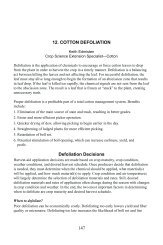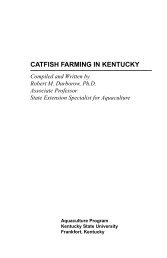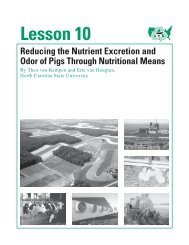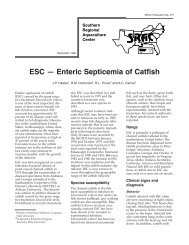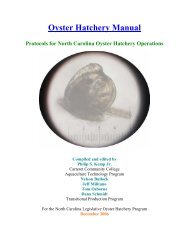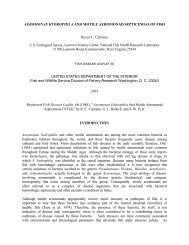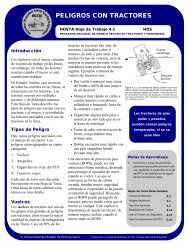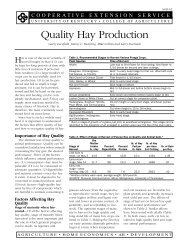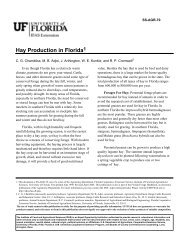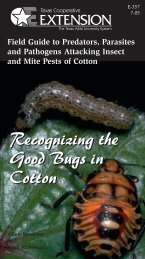Dryland Pastures in Montana and Wyoming - MSU Extension
Dryland Pastures in Montana and Wyoming - MSU Extension
Dryland Pastures in Montana and Wyoming - MSU Extension
You also want an ePaper? Increase the reach of your titles
YUMPU automatically turns print PDFs into web optimized ePapers that Google loves.
component of grass-legume mixtures is to seed the grass <strong>and</strong> the legume <strong>in</strong> alternate<br />
rows or to cross-seed them. Grass-legume mixtures require <strong>in</strong>tensive livestock<br />
<strong>and</strong> forage management. In most cases, the benefits of alfalfa <strong>in</strong> a grass mixture<br />
outweigh the potential risk of bloat. The bloat hazard can be reduced by replac<strong>in</strong>g<br />
alfalfa with low-bloat potential legumes such as sa<strong>in</strong>fo<strong>in</strong>, cicer milkvetch or birdsfoot<br />
trefoil.<br />
Cultivars<br />
After select<strong>in</strong>g species that are best suited for site conditions <strong>and</strong> the pasture’s<br />
<strong>in</strong>tended season of use, an appropriate cultivar must be selected. The potential<br />
benefits of us<strong>in</strong>g an improved cultivar are high because cultivar adaptation <strong>and</strong><br />
performance are proven. The Agricultural Experiment Stations <strong>in</strong> <strong>Montana</strong> <strong>and</strong><br />
Wyom<strong>in</strong>g <strong>and</strong> the Natural Resources Conservation Service conduct extensive trials<br />
for adaptation <strong>and</strong> performance of perennial dryl<strong>and</strong> forage species <strong>and</strong> cultivars.<br />
Producers should choose cultivars that have performed well <strong>in</strong> research trials on<br />
sites similar to their own. Information on cultivar performance is available through<br />
local <strong>Extension</strong> Service offices, Agricultural Experiment Stations <strong>and</strong> Natural<br />
Resources Conservation Service. In addition, the experience of local ranchers <strong>and</strong><br />
reputable seed dealers is <strong>in</strong>valuable when select<strong>in</strong>g species <strong>and</strong> cultivars. Cultivar<br />
attributes are compared <strong>in</strong> Appendix A (p. 23).<br />
Seedl<strong>in</strong>g Establishment<br />
Establish<strong>in</strong>g a successful dryl<strong>and</strong> pasture requires close attention to the follow<strong>in</strong>g<br />
details.<br />
Seed Source<br />
Certified seed should be used when possible. This ensures genetic <strong>and</strong> mechanical<br />
purity, cultivar identity, uniformity <strong>and</strong> m<strong>in</strong>imal risk of weed contam<strong>in</strong>ation,<br />
particularly noxious weeds. State <strong>and</strong> federal laws require dealers to label all seed<br />
offered for sale. The label lists the orig<strong>in</strong>, purity, species identity, percent germ<strong>in</strong>ation,<br />
other crops <strong>and</strong> weed seed content. Certified seed of a recommended cultivar<br />
that is produced <strong>in</strong> another state is acceptable, provided the species <strong>and</strong> cultivar are<br />
recommended for the site conditions <strong>and</strong> the <strong>in</strong>tended season of use.<br />
Seed of a given species that is collected from wild st<strong>and</strong>s or cultivars grown<br />
without certification is termed “common.” When buy<strong>in</strong>g common seed, it is<br />
important to know its orig<strong>in</strong> because local environmental conditions (e.g., temperature,<br />
precipitation, day length, grow<strong>in</strong>g season, soil, etc.) alter plant genetics.<br />
Seed from a species grown <strong>in</strong> one environment may not perform well <strong>in</strong> another<br />
environment. Generally, non-certified, common seed can be planted successfully<br />
up to 500 miles south <strong>and</strong> 300 miles north of the collection site.<br />
Precipitation levels <strong>and</strong> elevation strongly <strong>in</strong>fluence suitability of cultivars <strong>and</strong><br />
species when mov<strong>in</strong>g east or west from the collection site.<br />
— 15 —




